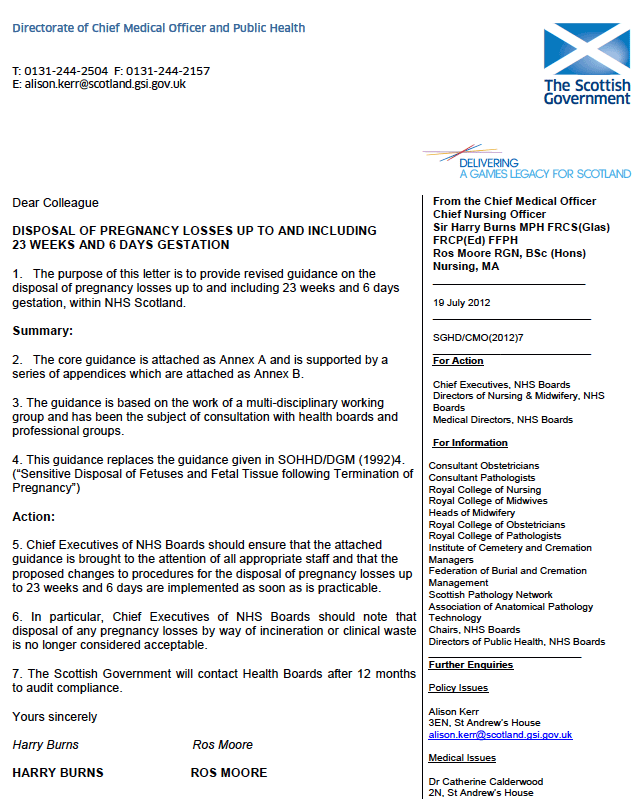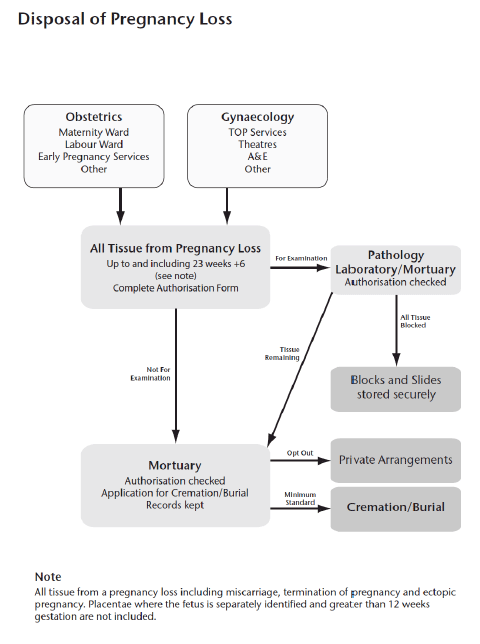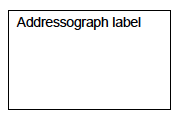Report of the Infant Cremation Commission
Report examining current practice regarding the cremation of infants and making recommendations for improvement for the future.
Annex K - CMO & CNO 2012 Guidance on Disposal of Pregnancy Loss

GUIDANCE ON THE DISPOSAL OF PREGNANCY LOSSES UP TO AND INCLUDING 23 WEEKS AND 6 DAYS GESTATION
1. This document updates the guidance given in SOHHD / DGM (1992) 4. ("Sensitive Disposal of Fetuses and Fetal Tissue following Termination of Pregnancy")
2. This guidance refers to disposal of all pregnancy loss up to and including twenty-three weeks and six days gestation, irrespective of cause or origin, where no signs of life have been detected following the loss, and whether or not fetal tissue can be identified.
3. This guidance does not refer to, or change, current procedures for the disposal of stillbirths occurring from twenty-four weeks and zero days gestation, nor does it change current procedures for the disposal of placentae.
4. In recognition of the sensitivity around early pregnancy loss[1],[2] disposal of any pregnancy loss by way of incineration or clinical waste is no longer considered acceptable.
5. This document outlines the minimum standard expected for the disposal by NHS Boards of all pregnancy losses, where the woman:
a) expresses a wish for the NHS Board to dispose of the pregnancy loss, or
b) declines to express any wish regarding disposal [see paragraph 7 (d)].
However, it is of course recognised that women have the right to make alternative personal arrangements.
6. Minimum standard for disposal:
The minimum standard is collective disposal in a crematorium. In circumstances where such disposal is not available, disposal by collective burial is acceptable. In either situation, "collective" is defined as a number of pregnancy losses, in individual sealed containers, collected together into a larger sealed container.(See Annex E)
7. Authorisation and opting out:
a) Information on available options for disposal should be made available to all women who experience pregnancy loss. Notes on drafting an information leaflet, and an example from one Board is at Annex B.
b) It is recommended that disposal should be authorised by the woman who has experienced the loss. An example of wording, which could be used as part of a consent form for a procedure or could be used as a stand-alone form , is at Annex C.
c) Women may decline disposal by the NHS Board in favour of making their own arrangements. In this case, the pregnancy loss should be stored and made available for collection by the woman or her agent. Such a decision must be recorded in the patient's notes.
d) Where authorisation for disposal, or declaration by a woman that she wishes to make alternative arrangements has not been received six weeks from the date of pregnancy loss, the NHS Board responsible for the woman's care at the time of the loss should, as a matter of good practice, proceed to make arrangements for disposal. Such an outcome must be recorded in the patient's notes.
8. Religious, ethical and cultural issues:
Where a woman wishes, for reasons of religious, ethical, or cultural preference, or for other reasons, to make alternative arrangements for disposal of the pregnancy loss, it is appropriate for the NHS Board concerned to offer advice and assistance. Costs incurred in any alternative arrangement will normally be the responsibility of the family.
9. Confidentiality:
In any communication with regard to collective disposal, to organisations outwith NHSScotland (such as crematoria), Boards should only identify a pregnancy loss by a unique disposal number, allocated for this purpose. Patient details, including Community Health Index Number, may not be shared outwith NHSScotland without express permission from the patient.
10. Audit:
The responsibility for maintaining a record of the disposal rests with the NHS Board and this record should be retained for a minimum of 30 years. NHS Boards should develop clear processes for the management and retention of this record within their own local record management systems and in line with Scottish Government guidelines on record management and with the terms of the Data Protection Act 1988 and the Abortion Act 1967. A recommended data set for the NHS record is outlined in Annex D. A suggested form of application for collective disposal of pregnancy losses, agreed with the Institute of Cemetery and Crematorium Management, is included as Annex F.
11. Timescales:
The disposal of a pregnancy loss should be arranged as soon as practicable, after authorisation is received.
12. Sensitivity:
In all matters relating to the disposal of pregnancy loss it should be remembered that this is a highly sensitive issue. Language used in communicating with women and their families should reflect this. Arrangements should be in place to provide, or signpost to, appropriate support.
13. Supporting documents:
Annexes accompany this guidance for information and advice only.
Annex A: Outline flowchart for decision making process
Annex B: Notes to aid development of local leaflets.
Annex C: Suggested wording for authorisation
Annex D: Recommended minimal data set for future audits
Annex E: Notes on packing and transportation of pregnancy losses
Annex F: Suggested application form for cremation of pregnancy losses
ANNEX A
Guidance on disposal of Pregnancy Loss up to and including 23 weeks and 6 days gestation
Flow Chart

ANNEX B
Guidance on disposal of Pregnancy Loss up to and including 23 weeks and 6 days gestation
Notes on drafting NHS Board information leaflet for patients
NOTE: This is for guidance only. Each Board will require to develop its own leaflets. Because of sensitivity of language, Boards are advised to develop two leaflets, one for women having terminations and one for miscarriages. All leaflets should be subject to the Board's own guidance on drafting and style. Examples are available from Boards currently using this system, such as NHS Ayrshire and Arran and NHS Tayside
| Heading |
Notes |
Example |
|---|---|---|
| Title |
The title should be sensitive |
Arrangements following the loss of your pregnancy |
| Introduction |
A clear statement of purpose, |
The aim of this leaflet is to provide you with information about what happens to your baby. We use the term Pregnancy Loss to refer to losses at any stage from conception until 23 weeks and six days. After 24 weeks gestation different procedures are required by law. |
| The leaflet should probably refer to national guidance |
the policy of NHS XXX complies with the national guidelines for the sensitive disposal of pregnancy loss. |
|
| What happens? |
Some simple basic description of the procedure. Note that some crematoria will not wish you to say where and when this takes place as they may not wish families to attend |
The pregnancy loss will be placed in a small individual box. It will be looked after in the mortuary and then be taken to a local crematorium along with other pregnancy losses, each in their own container |
| Reassurance about dignity is important |
Although a number of containers are transported and cremated together, be assured that each one is handled throughout the process with respect and dignity. |
|
| Will there be any ashes? |
It is important to state that ashes will not be available. [This is because of the absence of formed bone]. |
There are no cremated remains (ashes) from this process. |
| Is there a charge? |
No. NHS XXX will pay for this service |
|
| Can I go to the crematorium? |
This will be by local arrangement. Some crematoria will allow and some will not. There is no point in attending unless there is to be some form of committal. . If parents can attend, who will tell them when the committal will be? What if there is a delay for pathology? But there may be a local memorial garden |
You may wish to be present at the crematorium for the committal. If you would like to attend, please tell your midwife or the nurse who is looking after you within XX hours/days. Sometimes there is a delay before cremation, for example, if you have agreed to tests or an examination of your baby. A midwife/ a funeral director / our bereavement office will contact you to confirm the date and time of the cremation. There is not a service at the crematorium, but there is a children's memorial garden which you can visit at any time. |
| Can I make my own arrangements? |
The option to opt out is very important and might be actively encouraged for older gestations Remember there is a cost for this - unless the health board is paying |
Yes. You may wish to make alternative arrangements. These arrangements would need to be made privately. This private arrangement may be more appropriate to your needs, depending on the stage of your pregnancy. Private arrangements will ensure you have the type of service, cremation or burial that you prefer. To do this, you should contact a funeral director. Please be aware that you would have to pay the costs. The costs vary considerably between funeral directors and will depend on the arrangements and type of service you request |
| What if I cannot make a decision, or do not wish to make a decision |
The guidance has a default clause that where there is no decision the Board should dispose of the loss after 6 weeks |
You will understand that we cannot keep pregnancy loss in the mortuary indefinitely. If you have not indicated your choice to us after six weeks the NHS guidance allows us to make the decision and to arrange for your pregnancy loss to be taken to the crematorium |
ANNEX C
Guidance on disposal of Pregnancy Loss up to and including 23 weeks and 6 days gestation
Authorisation for sensitive disposal following pregnancy loss

Disposal of pregnancy loss
Complete either Section A or Section B. Delete whichever is not applicable
Section A:
The options for disposal have been explained to me Yes / No
I give authorisation for my pregnancy loss to be disposed of by the hospital in accordance with procedures outlined Yes / No
If no, please indicate if:
1) I have not yet decided, or
2) I will make my own arrangements through a funeral director, or
3) I wish to take my pregnancy loss out of the hospital
(release of tissue form to be signed)
I understand that if I change my mind I must phone the hospital
within [time to be agreed locally], Yes / No
Section B:
I have declined to discuss this matter and recognise that
the hospital will proceed according to their standard procedure
Signature of the woman………………………………………....
Date Signed ……………………………………………………....
Witness Signature…………………………………………………
Witness name (Block Capitals) …………………………………
Designation…………………………………………………………
RELEASE OF PREGNANCY LOSS TO THE WOMAN
(IF MAKING OWN ARRANGEMENTS)
I would like to take my pregnancy loss home following my discharge from the unit.
[Note: further paperwork may be required, for example to acknowledge health and safety issues.]
Ward……………………………………………………………………………………….
Name………………………………………………………………………………………
Hospital number……………………………………………………………………..……
Address…………………………………………………………………………………….
Signature of the woman………………………………………………………………..
Name of the Consultant………………………………………………………….………
Name of Nurse/Midwife completing form………………………………………………
Signature of the Nurse/Midwife………………………………………………
Date………………………………………………………………………………………...
Copy of form for case notes
Copy for woman to take away
Copy for pathology / mortuary
ANNEX D
Guidance on disposal of Pregnancy Loss up to and including 23 weeks and 6 days gestation
Recommended Dataset
These data items are for use within NHSScotland only.
A unique disposal number, generated in the Hospital Mortuary or elsewhere, should be used to identify the pregnancy loss to any external bodies, such as funeral directors and crematoria in order to protect sensitive data and preserve anonymity. No other data should be shared.
Traceability for parents in any subsequent enquiry would be through NHS records. To support this, the data should be held for a minimum of 30 years, with good practice being retention for 50 years.
Scottish Government guidance on collective disposal states that each pregnancy loss should be placed in a separate container, and these small containers may then be placed together in a large container for collective disposal.
| Patient Information: |
Woman's name: |
| Authorisation |
Name of person taking authorisation
|
| Disposal Information: |
Date received into mortuary Type of Disposal:
Name of applicant for cremation / burial Date of application for cremation / burial Date left mortuary Collected by:
|
| Identifiers: |
Unique disposal number (to be clearly marked on the small container and used in application for disposal) Large container number (to be clearly marked on large container and used in application for disposal) |
ANNEX E
Guidance on disposal of Pregnancy Loss up to and including 23 weeks and 6 days gestation
Packing and Transport
Arrangements for packaging and transport of pregnancy losses to the mortuary or pathology laboratories should follow local guidance, which should ensure that the pregnancy loss is at all times handled with dignity and respect.
Following surgical termination, where the pregnancy loss is contained within an evacuation vessel such a vessel must be of a material which is acceptable to the crematorium. For transport and disposal, the evacuation vessel should be placed within a suitable opaque container. There is no requirement to separate tissue from other fluids.
Following all other losses, the pregnancy loss should be wrapped and sealed according to local policy, and placed in an opaque container, ensuring that any material used is acceptable to the crematorium.
Each pregnancy loss should be labelled according to local policy with the name, address and CHI number of the woman.
When disposal has been agreed, individual containers should then be allocated a unique disposal number for disposal, and be placed within a larger container for collective disposal.
The large container should be securely sealed and labelled with an identifying code. No identifiable information should be visible. Again all material used must meet the requirements of the crematorium.
Transport to the crematorium should be carried out in a discreet, and dignified fashion, either by a funeral director or by hospital transport.
All pregnancy losses should be handled with dignity, care and respect.
ANNEX F
Guidance on disposal of Pregnancy Loss up to and including 23 weeks and 6 days gestation
Example of Application for Disposal of Pregnancy Loss at Crematorium[3]
This application must be signed by the person authorised by the Medical Director of the NHS Board to make an application for cremation. The pregnancy loss must only be identified by the hospital/clinic disposal number*.
This form must be completed fully. Please note that incomplete information may cause a delay in disposal.
I (name of applicant).................................................................................................................................
(position).....……………………………………………… NHS Board……...................................................
as the authorised and designated person, declare that I hold paperwork relating to each of the pregnancy losses listed below, signed by the medical practitioner/registered nurse/registered midwife whose name is shown, and that the paperwork includes a declaration that the pregnancy loss was of a gestation up to and including 23 weeks and 6 days and that the pregnancy loss showed no signs of life.
I hereby apply to **Anywhere ** crematorium to dispose of the following pregnancy losses:
| Large container number: |
Date sealed: |
|
| Identifying Number * |
Date of Delivery |
Name of medical practitioner / registered nurse / midwife whose signature appears on the NHS declaration |
* Note this is NOT the woman's CHI number or NHS number but a number generated by the NHS Board which identifies the appropriate records held by the NHS.
I DECLARE that all the information given in this application is correct, that no material particular has been omitted and that authorisation for the disposal has been obtained as in Scottish Government Guidance dated 2012.
Signature of Applicant.……………………………………………………...........Date..........................
Designation of Signatory………………………………………...........…….............................…….….
NHS Board: ………………………………………………………………….………………..……………
Address: …….……………………………….............………………....................................................
……………………………………………………………………..…..…..Post Code: …………..……….
Contact
Email: Sarah Dillon
There is a problem
Thanks for your feedback